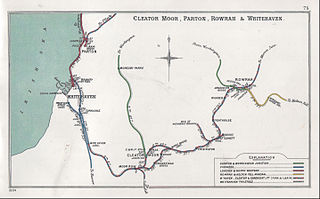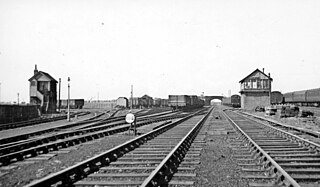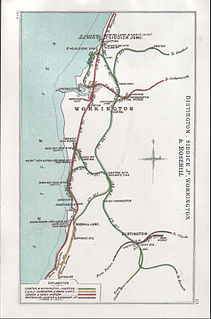
The original Cockermouth railway station was the eastern terminus of the Cockermouth & Workington Railway. It served the town of Cockermouth, Cumbria, England.

Broughton Cross railway station was situated on the Cockermouth and Workington Railway and served the village of Broughton Cross, Cumbria, England.

Camerton railway station was situated next to the River Derwent on the Cockermouth and Workington Railway. It served the village of Camerton, Cumberland, England.

Workington Bridge railway station was situated at the northern end of Workington Bridge next to the River Derwent, and was originally served by the Cockermouth and Workington Railway, later absorbed by the London and North Western Railway; the road at the north end of the bridge having to be raised to allow the railway to pass under it. It served eastern Workington, Cumberland, England.

Marron Junction railway station was a later addition to the Cockermouth and Workington Railway. It opened on 2 April 1866 with a single, eastbound, platform when the adjacent Marron Junction opened, two months before the company was absorbed by the London and North Western Railway.

Bridgefoot railway station was built by the Whitehaven, Cleator and Egremont Railway. It served the village of Bridgefoot, Cumbria, England.

Branthwaite railway station was built by the Whitehaven, Cleator and Egremont Railway. It served the village of Branthwaite, Cumbria, England.
Ullock railway station was built by the Whitehaven, Cleator and Egremont Railway. It served the village of Ullock, Cumbria, England.
Lamplugh railway station was built by the Whitehaven, Cleator and Egremont Railway. It served the scattered community of Lamplugh, Cumbria, England.

Winder railway station was built by the Whitehaven, Cleator and Egremont Railway. It served the village of Winder, Frizington, Cumbria, England.

Eskett railway station was short-lived as a passenger station. it was built by the Whitehaven, Cleator and Egremont Railway to serve the hamlet of Eskett, near Frizington, Cumbria, England.

Yeathouse railway station was a later addition to the Whitehaven, Cleator and Egremont Railway. It served the communities of Yeathouse and Eskett, near Frizington, Cumbria, England.

Frizington railway station was built by the Whitehaven, Cleator and Egremont Railway. It served the industrial Parkside area of Frizington, Cumbria, England.

The original Cleator Moor railway station was built by the Whitehaven, Cleator and Egremont Railway. It served the rapidly urbanising town of Cleator Moor, Cumbria, England.

Gillfoot railway station was on the Whitehaven, Cleator and Egremont Railway line half a mile north of Egremont station, in Cumbria, England.
St Thomas Cross Platform was a railway station used by workmen's trains on the Moor Row to Sellafield line on what is now the southeastern, Cringlethwaite, edge of Egremont, Cumbria, England.
Millgrove railway station was a private station on the Cleator and Workington Junction Railway (C&WJR) main line from Moor Row to Workington Central. It appears to have served the Burnyeat family who lived at a house named Millgrove in Moresby, Cumbria, England, which was near the company's main line. William Burnyeat (1849-1921) was on the company's Board of Directors from 1900 to 1921.

Harrington Junction was a railway junction in Harrington, Cumbria, England. It joined three branches to the Cleator and Workington Junction Railway's (CWJR) main line from Workington Central to Moor Row via Cleator Moor West. No station ever existed at the junction, High Harrington was the nearest, 48 chains (0.97 km) to the south.

Rosehill railway station was opened by the Cleator and Workington Junction Railway (C&WJR) on the company's Harrington Branch which connected with the Lowca Light Railway (LLR) at Rosehill to provide a through route from Lowca to Workington Central and beyond.

Linefoot railway station, sometimes referred to as Linefoot Junction and sometimes as Linefoot Goods, briefly served the scattered community around the crossroads at Linefoot, near Cockermouth in Cumberland, England.










